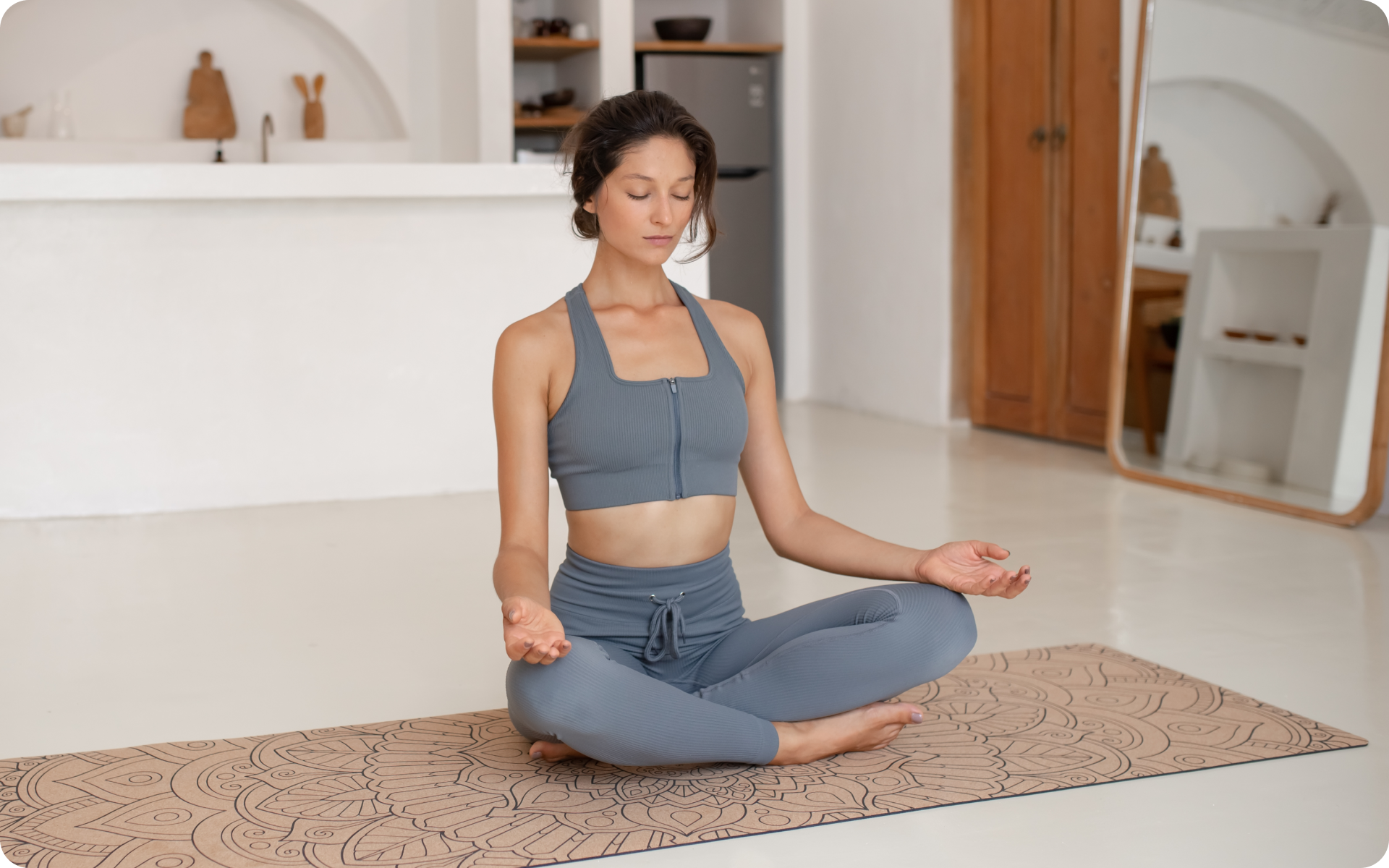Somatic techniques started to become popular a few years ago. Previously, many people solely used yoga and meditation for dealing with psychological symptoms. Somatic is a fairly new therapeutic approach that improves a person’s relationship with their body and promotes emotional regulation.
Contrary to popular belief, poor sleep or an unhealthy diet aren’t the only reasons you feel a disconnection between your mind and body. Sometimes the cause lies in your past.
Unhealed emotional wounds from the past can make us remain in a state of nervous system dysregulation. This creates a disconnect between our minds and bodies that can be difficult to rebuild. Even if we do not consciously understand it, chronic disconnection from the physical aspect of ourselves can impair our mental and emotional well-being. Therefore, the path to better emotional health starts with a mind and body reconnection.
In this article, we will discuss several somatic techniques that you can use for strengthening your connection with your body and re-establishing a sense of safety and calm.
What is Somatic Therapy?
People do not only experience life on a mental and emotional level – they also store memories and experiences in their bodies on a cellular level. A wound from the past is not just in our minds – we also carry it with us on a physical level. This is why we sometimes react in unusual ways or experience intense emotions to a seemingly insignificant event. Due to the interconnectedness between mind and body, we require tools that enable us to work with this latter component. This is where somatic therapy comes in. It helps us reconnect the symptoms we experience in our bodies so we can attune to them, listen to them, and befriend them. When this happens, the mind and body become aligned (2).
Criticism of somatic therapy was rife some years ago, but now many people are embracing it as a means of tackling trauma.
Creating a connection between the mind and body takes a great deal of time and effort. This article explores the ins and outs of somatic techniques and discusses the evidence behind these therapies to establish their validity.
Let’s take a look.
Whether you want to learn how to exit the spiral of self-harming behavior, overcome anxiety, cure insomnia or simply give yourself the time and space to bliss out and soak up the moment of complete peace and quiet – BetterMe: Meditation & Sleep app is exactly the tool for that! If you don’t take care of number one, who will?
What Are Some Somatic Therapy Techniques?
Initially, somatic therapies were introduced to help trauma survivors find relief from symptoms including flashbacks, sleep issues, eating disorders, and anxiety. However, over time, people started to use these therapies for multiple stressors. Their popularity in stress-related issues has now significantly increased.
Below are some common types of somatic therapy techniques that are recommended by somatic therapy experts:
Somatic Experiencing
Somatic experiencing is a body-focused approach that helps individuals address the sensations that accompany a traumatic memory. This is achieved by guiding the client to identify areas of tension in their bodies or by helping them name feelings or emotions that are associated with a distressing event. Unlike talk therapy, somatic experiencing does not require the client to tell the story of their past, and it works based on how they respond to it in the here and now.
If you are concerned about exploring these sensations, remember that a trained therapist will help you move safely through them. This will help you slowly stop feeling upset as you remember the distressing memories.
Hakomi Therapy
Hakomi therapy adopts a somatic-based approach to psychological growth. It draws on principles such as mindfulness, nonviolence, mind-body integration, and unity of the multiple parts that make up a person. (11).
Firstly, your therapist will try to create a calm and welcoming environment. They will then help you find signs in your body that compel you to act in a certain way. Uncovering these feelings will enable you to gradually move on to let go of them.
Neurosomatic Therapy
Another branch of somatic therapy, neurosomatic techniques, helps clients with extreme symptoms, such as those with musculoskeletal dysfunction.
Neurosomatic therapy helps improve poor posture by creating an understanding of the mind-body connection (12). Poor posture is often a result of traumatic experiences. During a neurosomatic session, the practitioner performs massage or corrective posture work to mitigate the issue.
Bioenergetics
According to bioenergetics, every person has innate healing abilities that they can use for treating stored trauma. In simple terms, an individual can tackle trauma by going through the experience and determining the root cause. Once the root cause is determined, the somatic practitioner will guide you through ways to cope with the trauma and heal your body (3).
Alexander Technique
The Alexander technique is an effective somatic technique that promotes improved posture and movement. Proponents of this technique suggest that poor posture causes tension in the body and problems such as back pain, neck ache, and sore shoulders. Undergoing this technique can help you improve your posture and gain a better understanding of how you move in general (1).
If you suffer from chronic back pain or have bad posture, you can use the Alexander technique to improve your gait and posture.
What Are Examples of Somatic Tools?
Science has now proven that stress can translate into physical symptoms. If symptoms from trauma remain in our bodies long enough, they manifest in problems such as tummy aches or back pain. This happens because when someone remains in a fight or flight response for a long time, they become more vulnerable to illness and stress.
Somatic Breathing Exercises
You can sit or lie down while performing this exercise. It’s a good way to start any practice or relax when you feel stressed. Remember that when you do somatic breathing exercises, it’s all about discovering what feels right for you.
Follow these steps when performing breathing exercises:
- Find a quiet spot: Choose a calm and comfy place to sit or lie down where you won’t be bothered.
- Get comfortable: Sit in a relaxed but straight posture. You can sit on a chair with your feet flat on the floor and your hands on your lap or lie down on your back with your arms by your sides.
- Start naturally: Take a few regular breaths to get used to your breathing pattern. Notice how your breath feels and where you feel it the most.
- Go deeper: Now, start taking slower and deeper breaths. Inhale deeply through your nose, allowing your lungs to fill with air. Feel your belly expand as you breathe in.
- Exhale slowly: Exhale slowly and fully through your mouth or nose. As you breathe out, try to release any tension or stress you may be holding onto.
- Focus on your breath: Pay attention to how your breath feels as it enters and leaves your body. Feel your chest rise and fall and your abdomen move. You can also choose a specific point, such as the feeling of air in your nostrils or the sound of your breath.
- Observe your thoughts: It’s perfectly normal for thoughts to enter your head during this exercise. You should notice them without judging and gently bring your attention back to your breath.
- Practice regularly: Breathing exercises work best when they are performed regularly. Try to set aside a few minutes every day for deep breathing. Over time, you’ll start to feel more relaxed and at ease.
Read more: Somatic Practices: What They Are and How They Work.
Somatic Grounding Exercises
Fight or flight response kicks in whenever you sense danger, which places your body in momentary stress. It is important to destress by grounding, i.e., shifting focus by splashing cold water on your face, doing controlled breathing, or changing your position by doing somatic movements such as sitting or standing. This relieves stress and calms the body (8).
Here’s how you can do grounding at home:
- Splash warm and cold water: You can start by washing your hands or splashing your face with cold water. Feel the chill spread through your wrists to your nails as you do this. Then wash them or your face with warm water and see how the sensation feels. Repeat this a few times until you feel a sense of calm.
- Move your body: You can change your position by sitting, standing, stretching, jogging, walking, or dancing. You can do whatever you wish, as long as you are moving. As you progress, scan your body and try to find sensations of stress starting from your toes to your head.
- Tense and relax your body: You can also free your body from stress by tensing your body. For example, press your toes to the ground as hard as possible and slowly release them. As you do this, feel the sensations where you touch the ground and lift. This will help bring calm.
Resourcing
Resourcing is one of the best somatic techniques for coping with negative experiences by thinking about positive experiences (9). During the session, you will be told to think about a time when you felt truly happy. When you think about positive moments, your body experiences a good change, and you release stress.
You can also think about someone who makes you feel loved and happy. You can go through their photos or talk about them. Exercising this technique regularly will allow you to control your feelings and help you navigate stress easily.
Titration
In a chemistry lab, titration involves adding a solution to another until it dissolves. Titration in somatic therapy works on a similar principle, but instead of processing a traumatic event all at once, you slow down and work with just one sensation and memory at a time. The tracking of difficult and intense sensations is followed by anchoring into positive and uplifting ones. In this way, the body has time to integrate the negative memory before diving straight into another one. (5).
During titration, you may be asked to recall a traumatic incident and talk it through. As you go through the traumatic experience slowly, your body can show physical signs of distress. This may vary from person to person. The individual determines the pace and intensity, as everybody handles stress in different ways.
When you experience a painful incident, you control how your body reacts and let this experience be cathartic. Your body can slowly relieve stress and get better by allowing bottled-up emotions to leave it.
Pendulation
Pendulation is when you experience loops of stress and calm. Like a pendulum, you move to and from stressful moments to completely calm experiences. The aim of pendulation is to create a balance between stress and calm (6).
When you experience trauma, your body becomes stuck in a constant state of stress, and you may find it difficult to escape it. Pendulation can reverse that and help your nervous system return to its original functionality. This therapy uses somatic exercises for trauma to relive positive experiences.
Pendulation can also help achieve homeostasis where the body becomes balanced again. To achieve this, scan your body and identify the spot where you feel stress and actively feel it. Now, check your body to find areas where you feel calm and record this sensation. Keep this loop going until you experience both feelings in your body.
With stress being a constant presence in our lives, taking time to process emotions, decompress and get into the right frame of mind is absolutely crucial. With BetterMe: Meditation & Sleep app your mental health is in good hands! Start using it now!
What Are Three Examples of Somatic Techniques?
Somatics can help people release their pent-up emotions and identify sensations and emotions in their bodies. Sometimes you may feel anxious or unable to move on following a painful incident. Somatic techniques for anxiety can help people with PTSD or trauma befriend their emotions and relieve built-up stress.
Let’s now explore some of these easy, at-home somatic techniques.
Self-Regulation Somatic Techniques
When you experience trauma, you may lose control of your senses and emotions. It is important to learn what your feelings are telling you and how you can navigate them. This can be done by self-regulation, i.e., getting in touch with how you process trauma. Here’s how you can perform self-regulation at home (10).
- Hug yourself tightly: You can create a sense of calm by hugging yourself by crossing your right arm over your chest and placing your left hand on your right shoulder. This position will help you feel calm and safe.
- Squeeze your body: You can also squeeze different areas of your body or do cupping by tapping your cupped hand all over your body. This kind of grounding helps regulate your emotions and sensations. This technique also creates a sense of calm and safety.
Body Scans
Body scans are also effective for letting go of stress. To do this, start by sitting in a quiet and comfortable corner. Close your eyes and focus on your lower body. Feel your toes, feet, ankles, legs, thighs, and temperature or pressure sensations.
Wherever you feel stress, take a deep breath and exhale profoundly. After you have covered your lower body you can move to your upper body and repeat the action. Once you have covered your body, you may feel a sense of relief.
Smiling
Who knew that a simple facial exercise could do wonders for your mental well-being?
Smiling releases neurotransmitters, which are the brain’s feel-good hormones (6). Try smiling and imagining a pleasant experience whenever you feel stressed or tired. Even a half-smile can work wonders. You may feel stress gradually leaving your body.
What are the Five Channels of Somatic Experiencing?
SIBAM, or the somatic experiencing model, was developed by Peter Levine in the 70s and is a framework depicting five channels of somatic experiencing: sensation, image, behavior, affect, and meaning (7).
Sensation
Sensation is the first step in the SIBAM model. This is about experiencing and feeling the various sensations throughout the body (4). Sensations may include your position in space, muscle tension or fatigue, and how your feet touch the ground.
When you experience trauma, it may impact your sensations. Some sensations can become overly heightened, while you may lose focus on others. As infants, we explore the world through our senses, so we should reconnect with our feelings.
During a somatic therapy session, the practitioner will ask how you feel. People often respond by identifying their anxiety or fear. Then, the practitioner will ask what sensations you are experiencing. This can allow you to control the various sensations and accurately respond to your thoughts.
Image
Image is the second step in the SIBAM model. This refers to visual memories that include the five senses, such as dreams or experiences. Image channels can allow you to navigate external and internal affairs and involve explicit and implicit memories.
Behavior
Behavior refers to your observable behavior that the somatic practitioner notices during the session. Verbal behavior includes changes in tone, facial expressions, and sounds, while non-verbal behavior refers to your posture, involuntary movements, breath, and other gestures.
These voluntary movements can become your habits over time, and you may lose your focus. The somatic practitioner will help you slow down and tune into these sensations deeply. You may be asked to feel your pulse to bring awareness and calm your fight or flight response.
Affect
Affect is the fourth step in the SIBAM Model and refers to your emotions and feelings. People can experience emotions such as fear, sadness, anger, joy, and disgust as a result of a trauma (4).
Some people cannot experience happiness, love, or excitement. During a session, the practitioner will ask you to describe the emotions or where you feel the sensations in your body. This practice can enable you to detach physical sensations from your body and experience positive emotions.
Meaning
Meaning is the fifth and final step in the SIBAM model. This shows that memories and traumatic experiences can be translated into words that are crucial for mitigating stress.
Read more: 28-Day Somatic Exercise for Trauma Relief
The Bottom Line
Somatics acknowledges the connection between the mind and body. Whatever we feel, our bodies can express these emotions. People who have experienced painful or depressing incidents in the past can act in a certain way. They must overcome these impacts in order to live a satisfied life.
Somatic techniques can be effective tools for navigating stress and helping us feel calm. However, finding an experienced somatic therapist can be challenging, but you can discover some experts through an internet search or by asking around. Once you start seeking their assistance, you are likely to notice a gradual improvement in yourself.
Frequently Asked Questions (FAQs)
What are somatic techniques for emotional release?
Some somatic techniques for emotional release include grounding, resourcing, titration, and pendulation. These techniques can help with emotional release and the achievement of calmness.
Can I do somatic therapy on myself?
You can perform self-somatic therapy through breathing exercises, smiling, or by doing somatic movements at home.
Is mindfulness a somatic technique?
Mindfulness is a somatic technique that can help you to tap into your inner self. When you meditate, you calm your busy mind and become detached from your thoughts. This can calm your nervous system.
What is a somatic approach to trauma?
The somatic approach to trauma helps people deal with PTSD. In addition to focusing on emotions after a traumatic event, this approach also considers the bodily responses.
DISCLAIMER:
This article is intended for general informational purposes only and does not serve to address individual circumstances. It is not a substitute for professional advice or help and should not be relied on for making any kind of decision-making. Any action taken as a direct or indirect result of the information in this article is entirely at your own risk and is your sole responsibility.
BetterMe, its content staff, and its medical advisors accept no responsibility for inaccuracies, errors, misstatements, inconsistencies, or omissions and specifically disclaim any liability, loss or risk, personal, professional or otherwise, which may be incurred as a consequence, directly or indirectly, of the use and/or application of any content.
You should always seek the advice of your physician or other qualified health provider with any questions you may have regarding a medical condition or your specific situation. Never disregard professional medical advice or delay seeking it because of BetterMe content. If you suspect or think you may have a medical emergency, call your doctor.
SOURCES:
- Alexander Technique (n.d., sciencedirect.com)
- All About Somatic Therapy (2021, psychcentral.com)
- Bioenergetic Therapy – What It Is All About? (2023, psychcrumbs.com)
- How The SIBAM Model Can Help You Overcome Trauma (2021, redbeardsomatictherapy.com)
- On The Importance of Titration for Trauma Healing (10 Benefits) (2016, new-synapse.com)
- Pendulation Exercise – Connecting to Resources (Pendulation Article 1) (2014, new-synapse.com)
- SE™ & Traumatic Coupling Dynamics (2023, tulamountainbodywork.com)
- Somatic Therapy Exercises and Techniques (2023, firstsession.com)
- Somatic Experiencing Therapy: 10 Best Exercises & Examples (2020, positivepsychology.com)
- The Science Behind PTSD Symptoms: How Trauma Changes the Brain (2021, psychcentral.com)
- What Is Hakomi Therapy? (2022, verywellmind.com)
- What Is Somatic Therapy? (2023, health.com)














